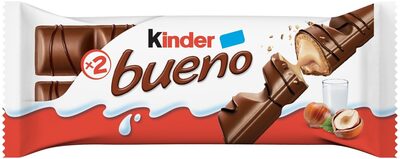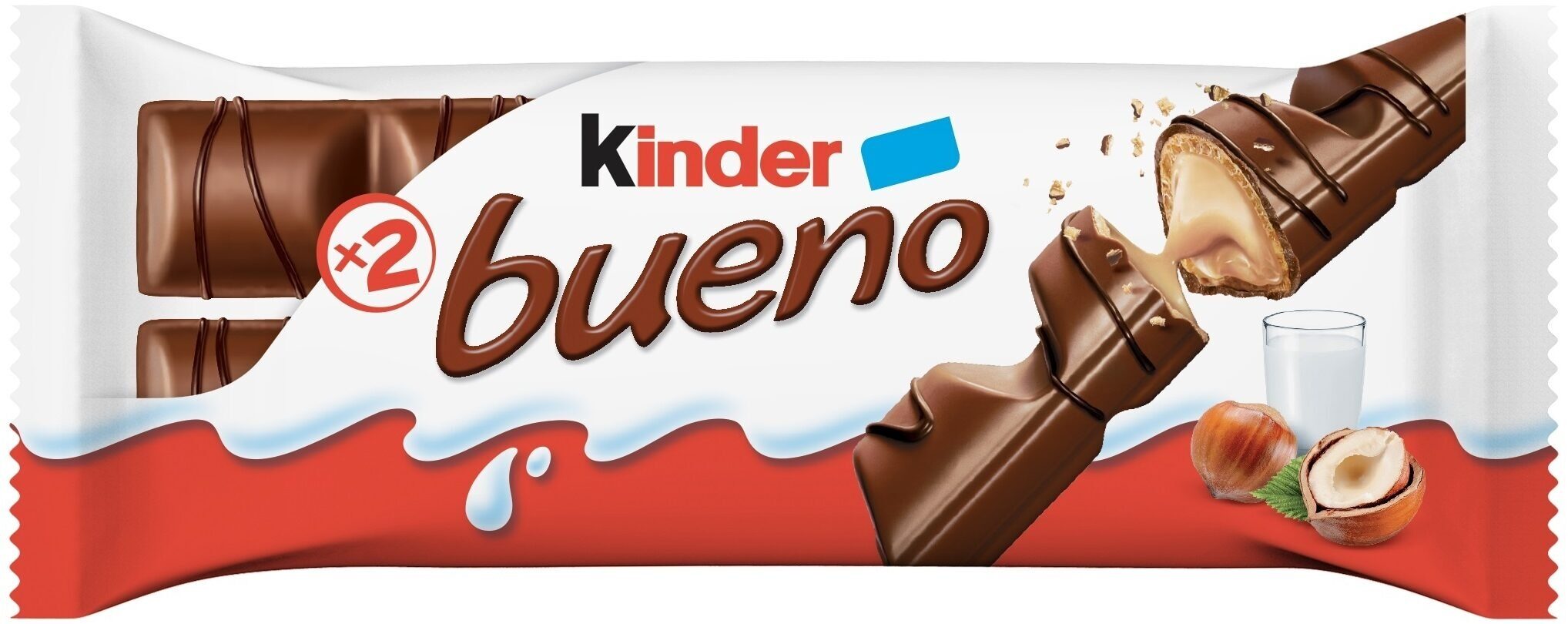Kinder Bueno - 43g
This product page is not complete. You can help to complete it by editing it and adding more data from the photos we have, or by taking more photos using the app for Android or iPhone/iPad. Thank you!
×
Some of the data for this product has been provided directly by the manufacturer FERRERO FRANCE COMMERCIALE.
Barcode: 8000500037560 (EAN / EAN-13)
Quantity: 43g
Packaging: fr:PENSEZ AU TRI ETUIS PLASTIQUES 3 CONSIGNE POUVANT VARIER LOCALEMENT >> www.CONSIGNESDETRUFR
Categories: Snacks, Sweet snacks, Cocoa and its products, Confectioneries, Bars, Chocolate candies, Bars-covered-with-chocolate, Chocolate biscuity bars, Chocolate nuts cookie bars
Labels, certifications, awards:
Green Dot, Pure cocoa butter
Link to the product page on the official site of the producer: http://www.ferrero.fr/fc-2738/#nav=kinde...
Stores: Cora
Countries where sold: Algeria, Belgium, France, Germany, Italy, Morocco, Spain, Switzerland, Tunisia, United Kingdom, United States
Matching with your preferences
Health
Ingredients
Food processing
Additives
Ingredients analysis
Nutrition
Environment
Carbon footprint
Packaging
Transportation
Threatened species
Other information
Conservation conditions: A conserver au sec et à l'abri de la chaleur
Customer service: FERRERO FRANCE COMMERCIALE - Service Consommateurs, CS 90058 - 76136 MONT SAINT AIGNAN Cedex
Report a problem
Data sources
The manufacturer FERRERO FRANCE COMMERCIALE uses Equadis to automatically transmit data and photos for its products.
Product added on by openfoodfacts-contributors
Last edit of product page on by org-ferrero-france-commerciale.
Product page also edited by 9lolita, alexg, arnouvion, autorotate-bot, bachirmeknii, bassel777, baudichouxd-1237, beniben, catiminidu84, date-limite-app, debuch, del51, desan, djallil-med, ecoscore-impact-estimator, fafa25, feat, ferrero, freezer, gavingt, gyrostat, halal-app-chakib, hugopeuze, hungergames, inf, kiliweb, kmilleu, koyot, lesupercrafteur, looping1234, lucaa, moon-rabbit, nicolasleger, off.2cdd7dae-1326-410c-ab80-5ac1932769ca, packbot, product-scan-com, roboto-app, scanbot, sebleouf, smoothie-app, tacite, tagah, teolemon, testuser, thaialagata, the-redburn, yuka.R3Z3NkhhZ1FxZDA3dHNVWHBoNy8rY291eUwzd2QwbWRlL3RQSUE9PQ, yuka.RnBzWktxUU1uZkExeHNSbS9SbmwvL0Yrd2JtNGQwN3VLdG9XSWc9PQ, yuka.RzRRRkRwd2FvOGtOeE1FanhEekY0ZnNveFppNFJETHZkN1FqSVE9PQ, yuka.UXJFbU5xWStpcVk3Z2NVRTF6VDQxOUZTN01TdWJHRzljZWRJSUE9PQ, yuka.UjdFdkNaUXVvTmNQaFBRMTFSblh4OU5MMkxDZ0JXSzlCdll1SVE9PQ, yuka.VGYwTVBhWTl1NllTd01BWDhqandvdlJxM2FDNUJIS21JdWdESWc9PQ, yuka.VzRkUUVKZ1R0djBqcE5zRjN3L2JxODF2NTdLcVV6bVFFY2dlSWc9PQ, yuka.WG80a0M0UXdvS0VGaWNOZy9CYkUrb04vNXB1Z2RGNjRlL1U4SUE9PQ, yuka.WWFjSFFZa1orZDhhbmZJRTdoL2M1dk4xM28yeFJXV2VOdkE4SVE9PQ, yuka.WjdzUVNhOE92dUFEdnMwQ293aUU5NDlNbVppbVRIR3ZOOVFJSWc9PQ, yuka.ZFBzbVRLc20rOU5VbzhVUzl6TGx4L1Y0OVpTT2VudTZkK2szSVE9PQ, yuka.ZXZrYlN2dzVtL1FEcE5nRzhFdjMrOE5aNnFYNFFVbnNDc00xSVE9PQ, yuka.ZjRjRkFmOC9wUEJRa2NkdTlFN3RvZk5reVpyM1JVNjhGczRBSWc9PQ, yuka.Zjc0TkZZc0lpT1lvdU1BbDJBcjI5TXhjNjc2MkIwMm5HOGdlSWc9PQ, yukafix, zoneblockscommunity.






